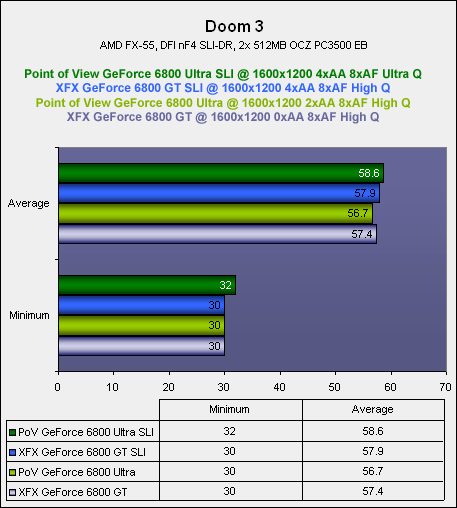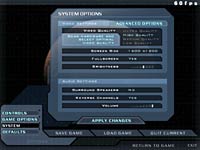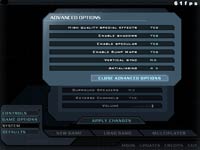
How We Tested:
Please be aware that the way we test our video cards is not a like-for-like comparison, and it is not meant to be. We decided to concentrate on finding the “Best Playable” settings - this means that we're finding the best possible gaming experience delivered on each different configuration. There are no time demos used in our evaluations - we're focusing on the real-world gaming experience, which is, ultimately what should determine your next graphics card's purchase.
System Setup
AMD Athlon 64 FX-55 (operating at 2600MHz - 13x200); DFI LANPARTY nF4 SLI-DR (NVIDIA NForce4 SLI); 2 x 512MB OCZ Enhanced Bandwidth PC3500 (operating in dual channel with 2.5-2-2-5 timings); Western Digital 200GB Caviar SATA 150 Hard disk drive; OCZ PowerStream 520W Power Supply; Windows XP Professional Service Pack 2; DirectX 9.0c; NVIDIA NForce4 Standalone chipset drivers, version 6.53; NVIDIA Forceware display drivers, version 71.89.
Video Cards:
The video card drivers were left at their default settings with the exception of Vsync, which was disabled in all cases.
We are using the full retail version of Doom 3 patched to version 1.1 and we used a section of the “Caverns” level to do a manual run through for the purposes of this comparison. Anti-Aliasing and Anisotropic Filtering were configured from inside the game, and thus we've left the drivers set to “Application Controlled”.
Due to the darkness of Doom 3, we find that increasing the resolution has greater image quality benefits than applying AA to a lower resolution.
First off, lets start with the single card configurations before moving on to what we were able to experience after adding the second video card in to the fold. The Point of View GeForce 6800 Ultra was capable of delivering a smooth gaming experience at 1600x1200 with 2xAA 8xAF at 'High Quality'.
With XFX's GeForce 6800 GT, we found that 1600x1200 with 0xAA 8xAF at 'High Quality' provided the best possible gaming experience - this comes as no surprise to us, and 2xAA was slightly too laggy in some parts of the title. However, the game receives greater image quality benefits from increasing resolution over Anti-Aliasing.
Once we added a second video card in to the fold, things started to get interesting. Doom 3 uses a standard Alternate Frame Rendering method, as defined by nvapps.xml. The field 'multichip_rendering_mode' is the important one here.
The pair of Point of View GeForce 6800 Ultra's managed one better, allowing us to increase the texture quality to Ultra Quality, meaning that we were able experience completely smooth game play at 1600x1200 with 4xAA 8xAF at 'Ultra Quality'.
 The difference between Ultra Quality and High Quality texture details was not that great, it just meant that the textures used with the Point of View GeForce 6800 Ultra SLI were completely uncompressed, whereas the XFX GeForce 6800 GT's textures were slightly compressed to improve performance, and more importantly keep the minimum frame rate above 30 frames per second. In general, we saw no visible in-game differences between High Quality and Ultra Quality textures, and it took us time to spot the differences in screenshots.
The difference between Ultra Quality and High Quality texture details was not that great, it just meant that the textures used with the Point of View GeForce 6800 Ultra SLI were completely uncompressed, whereas the XFX GeForce 6800 GT's textures were slightly compressed to improve performance, and more importantly keep the minimum frame rate above 30 frames per second. In general, we saw no visible in-game differences between High Quality and Ultra Quality textures, and it took us time to spot the differences in screenshots.
Please be aware that the way we test our video cards is not a like-for-like comparison, and it is not meant to be. We decided to concentrate on finding the “Best Playable” settings - this means that we're finding the best possible gaming experience delivered on each different configuration. There are no time demos used in our evaluations - we're focusing on the real-world gaming experience, which is, ultimately what should determine your next graphics card's purchase.
System Setup
AMD Athlon 64 FX-55 (operating at 2600MHz - 13x200); DFI LANPARTY nF4 SLI-DR (NVIDIA NForce4 SLI); 2 x 512MB OCZ Enhanced Bandwidth PC3500 (operating in dual channel with 2.5-2-2-5 timings); Western Digital 200GB Caviar SATA 150 Hard disk drive; OCZ PowerStream 520W Power Supply; Windows XP Professional Service Pack 2; DirectX 9.0c; NVIDIA NForce4 Standalone chipset drivers, version 6.53; NVIDIA Forceware display drivers, version 71.89.
Video Cards:
- 2 x Point of View GeForce 6800 Ultra - operating at their default clock speeds of 425/1100MHz in SLI mode.
- 2 x XFX GeForce 6800 GT - operating at their default clock speeds of 350/1000MHz in SLI mode.
- 1 x Point of View GeForce 6800 Ultra - operating at its default clock speeds of 425/1100MHz.
- 1 x XFX GeForce 6800 GT - operating at its default clock speeds of 350/1000MHz.
The video card drivers were left at their default settings with the exception of Vsync, which was disabled in all cases.
_____________________________
Doom 3
Publisher: ActivisionWe are using the full retail version of Doom 3 patched to version 1.1 and we used a section of the “Caverns” level to do a manual run through for the purposes of this comparison. Anti-Aliasing and Anisotropic Filtering were configured from inside the game, and thus we've left the drivers set to “Application Controlled”.
Due to the darkness of Doom 3, we find that increasing the resolution has greater image quality benefits than applying AA to a lower resolution.
First off, lets start with the single card configurations before moving on to what we were able to experience after adding the second video card in to the fold. The Point of View GeForce 6800 Ultra was capable of delivering a smooth gaming experience at 1600x1200 with 2xAA 8xAF at 'High Quality'.
With XFX's GeForce 6800 GT, we found that 1600x1200 with 0xAA 8xAF at 'High Quality' provided the best possible gaming experience - this comes as no surprise to us, and 2xAA was slightly too laggy in some parts of the title. However, the game receives greater image quality benefits from increasing resolution over Anti-Aliasing.
Once we added a second video card in to the fold, things started to get interesting. Doom 3 uses a standard Alternate Frame Rendering method, as defined by nvapps.xml. The field 'multichip_rendering_mode' is the important one here.
<PROFILE Label="Doom 3">We found that a dual XFX GeForce 6800 GT combination was capable of delivering a silky smooth gaming experience at 1600x1200 with 4xAA 8xAF at 'High Quality'.
< APPLICATION Label="doom3.exe"/>
< PROPERTY Label="prevent_cpl_af" Value="1" Itemtype="predefined"/>
< PROPERTY Label="multichip_rendering_mode" Value="1" Itemtype="predefined"/>
< PROPERTY Label="multichip_ogl_options" Value="0" Itemtype="predefined"/>
< /PROFILE>
The pair of Point of View GeForce 6800 Ultra's managed one better, allowing us to increase the texture quality to Ultra Quality, meaning that we were able experience completely smooth game play at 1600x1200 with 4xAA 8xAF at 'Ultra Quality'.


MSI MPG Velox 100R Chassis Review
October 14 2021 | 15:04









Want to comment? Please log in.